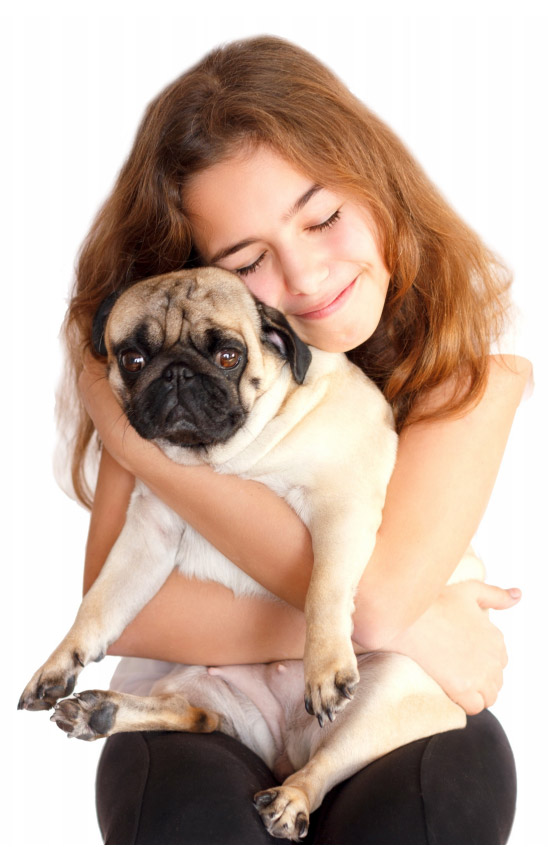Medial patella luxation (MPL) is a common orthopedic disorder in small and toy breed dogs. Poodles represent the most common breed affected. The word patella is the anatomic term for the kneecap, luxation infers “out of position” and the definition of medial is “toward the middle”. Less commonly the patella moves (luxates) toward the outside which is termed lateral patella luxation. Lateral patella luxations and less common, but most prevalent in large breed dogs. However, both small and large breeds can develop either. Medial and lateral patella luxations usually develop in young dogs between six and nine months of age.

Patella luxations usually occur secondary to hereditary, congenital abnormalities in limb alignment and both rear legs are affected. In many cases the leg(s) are “bowed” and the groove where the patella glides (trochlear groove) is often shallow and malaligned. Rarely, trauma causes the patella to luxate.
Clinical signs of patella luxations are variable and dependent on the grade or severity of luxation. Usually, clinical signs become apparent prior to one year of age. In mild cases, there are no obvious clinical signs. In moderate cases the puppy or dog occasionally limps or “skips” and a clicking or popping sound is present. The patella can also be felt popping in and out of position. In severe cases, “duck walking” and persistent limping is present. In some dogs the bow-legged deformity is obvious.
Infrequently, dogs live for years with patella luxations without clear clinical signs only to develop lameness in later life. In this scenario many times an ACL tear is responsible for the late onset of lameness. In some patients with late onset of signs, severe osteoarthritis secondary to the patella problem is the culprit.
Diagnosis of patella luxation is primarily based on physical examination. Radiographs are helpful, but with grade one and two patella luxations the patella may be in the appropriate position when the radiograph is snapped, i.e., seeing the patella in position on a radiograph does not rule out a patella luxation. Arthroscopy may also be useful in patella luxation cases to evaluate the cartilage wear and rule out other stifle joint disorders such as ACL tears.
Treatment options for patella luxations are dependent on the underlying anatomic abnormalities leading to the luxation. For asymptomatic patients, especially those with grade one luxation, surgery may not be needed. Dogs with spontaneously luxating patellas, require surgery to resolve clinical signs and prevent and minimize the development of osteoarthritis, such as cartilage erosion.
Typical treatment techniques include releasing one side of the joint capsule, tightening the opposite of the joint capsule (imbrication), deepening the grove where the patella normally glides (trochleoplasty), realigning the attachment point of the patella tendon, and in severe cases, straightening the femur (also know as distal femoral osteotomy or DFO). In routine cases surgery takes less than one hour and virtually all patients can leave the hospital the day of surgery.

The prognosis for patella luxation repair is excellent in dogs with grades 1-3. At Colorado Canine Orthopedics patients can be comfortably discharged from the hospital the day of surgery. Healing time depends on the age of the patient and procedures employed. In puppies healing usually takes about one month. During this convalescent period animals can go on short leash walks, do lots of lap sitting but should not be permitted to jump from furniture or stairs. Following healing the patient can return to a normal, fully active lifestyle.
The average cost of a patella surgery at Colorado Canine Orthopedics can vary from patient to patient due to factors that may be hard to determine until a physical examination has been completed. Please contact our office to discuss a pre-consultation estimate for your pet. A refined, doctor specified estimate will be presented at the end of your pet’s initial consultation.
About Our Fees:
At Colorado Canine Orthopedics we are committed to providing only state of the art, non-compromised pet healthcare. We realize some pet owners may find this level of care relatively costly. However, despite the inherently expensive nature of our work, we are dedicated to providing the highest level of care at the most affordable price possible. We believe if you compare our fees to other specialty practices you will find this true.


Colorado Canine Orthopedics
5528 North Nevada
Colorado Springs, CO 80918
Tel: 719-264-6666

Call our office today and speak with one of our Pet Care Coordinators to schedule a consultation.

Call our office today and speak with one of our Pet Care Coordinators to schedule a consultation.

Colorado Canine Orthopedics
5528 North Nevada
Colorado Springs, CO 80918
Tel: 719-264-6666